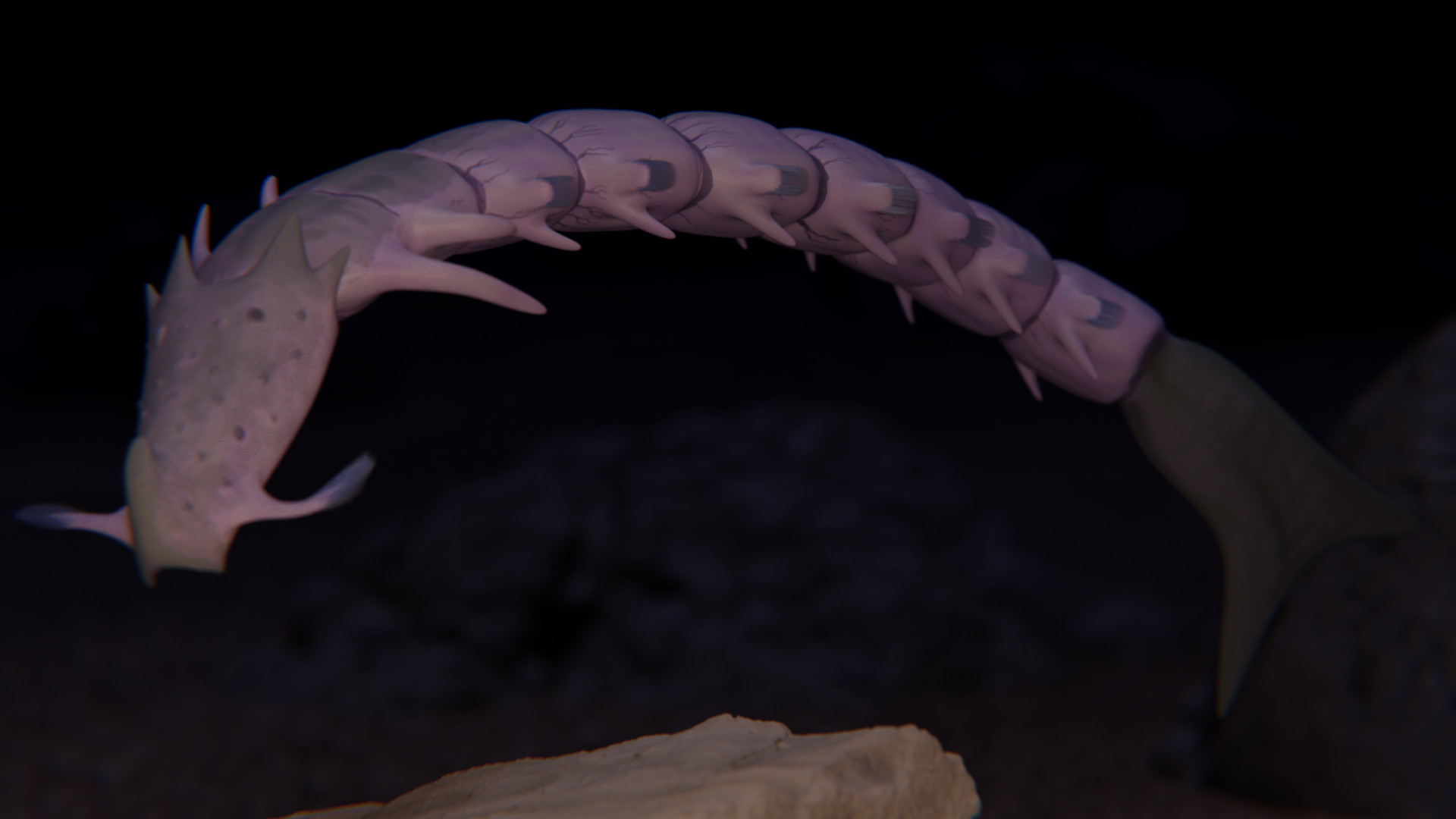Wyrm Fish
The wyrmfish is a bottom dweller in the dim twilight zones of Almaishah around the margins of Yama and Natash. The cephalic gills are retracted due to being startled. [Creature design by Ding Dong]
Basic Information
Anatomy
Wyrm fish have adapted their ancestral fins into modestly efficient walking limbs on most of the segments of their body. Their adorned head is covered in large flat armored plates, with spiked protrusions on the dorsal margin and the posteroventral corners projecting posterolaterally, for defense. They use hardened points on the ventral surface of the anterior portion of the first tagma to break the hard shells of prey and carcasses by repeatedly slamming their heads against them and disturbing sediment much like a hoe, once prey is reasonably "chewed" they can consume the meal through the leech like mouth on the underside of their head. Wyrm fish species are also sexually dimorphic with the last tagma of their body having claspers adapted from ancestral fins in males, they do not have any parental instinct and females will bury and abandon their eggs upon fertilization. Small simple brains are present in the anterior most tagma. Their gills remain quite basal, having a small frill of external gills extending from the back of each segment. But, unlike their deep sea cousins, Wyrm Fish have retained the ability to free swim, with their locomotive fins not being as compact and dedicated to "walking" across the sea floor. To aid in a quick escape from the sea floor they have adapted the last tagma of their body into a down turned whale or dolphin like fluke for most efficient lift. They paddle their many fins to aid in balance. And, as a side effect of their use of free swimming their armor is a bit lighter than the related sleeping fish, being more leathery and being almost completely gone in the fluke tagma. Their gills posterior to the cephalon are partially internalized, with the large feathery fins of the second tagma spasmatically beating to force water across them. Those large feather fins of the second tagma are not used for locomotion and are incredibly thin and delicate being filled with many large veins. These fins are mainly kept folded and close to the body, but during mating season or when threatened by a predator they will fan them out and pump them with their hemocyanin based blood giving them are large blue frill to scare off would be attackes and attract mates. Their front most tagma is thin and mainly built for hydrodynamics, with two large spikes on the bottom and a ramp shaped crest on the front allowing for more effective disturbance of the sediment. The gills on this tagma have evolved into long whisker like feelers, and some pressure sensing bumps can be found on their "snout". They have also retained two simple eyes, which are placed on the central top of their head for better spotting of predators but limiting their range of view.
Genetics and Reproduction
During mating, females with release strong scents from their cloaca, attracting males and when releasing eggs they release all of them in a large sac before burying them in the sediment. Sometimes these sacs can retain the scent and other wyrm fish may cannibalize the eggs.
Ecology and Habitats
Wyrm fish live from the bottom of the pipelagic to the bottom of the mesopelagic (twilight) zone of Almaishah around the continents of Yama and Natash.
Dietary Needs and Habits
Wyrm fish are mostly scavengers, but also hunt for what prey they can find in their dimly lit habitat. They feed primarily on the remains of other "animals" as well as phytozoans.
Additional Information
Geographic Origin and Distribution
Around Yama and Natash
Perception and Sensory Capabilities
Chemo receptors are positioned on the front edge of the underside of their head and around their mouth. Due to the lack of light they have lost most function in the eyes in favor of pressure sensors acting like a sense of long range touch, manifesting as large bumps on the tops of their head plate. The eyes are on the posterodoral portion of the cephalon and are covered by a thin layer of skin and keratin to protect them. They largely only detect light levels which aids in the keeping the circadian rhythms of the organisms in sync with the planet's rotation.
EXTINCT
Genetic Ancestor(s)
Scientific Name
Ichthyodracon wushuii
Origin/Ancestry
Xenosegmenta
Average Length
12" / 30.5 cm
Remove these ads. Join the Worldbuilders Guild











Comments